Heteromeles arbutifolia
Otherwise known as toyon, California holly, or Christmas berry, Heteromeles arbutifolia is an excellent slope-stabilizing and habitat plant, host to myriad insects including pollinating butterflies and moths.
An iconic staple of California chaparral and oak woodlands, this evergreen shrub grows most commonly on north facing slopes, hill bottoms, and canyons.
Low maintenance and with low water requirements once established, this monoecious plant is an excellent choice for native wildlife gardens. Resilient in the face of flames, toyon easily sprouts back from its crown after wildfire.

We link to vendors to help you find relevant products. If you buy from one of our links, we may earn a commission.
Leathery, dark green leaves with serrated edges and pale undersides shape the woody contours of this species, with the rough gray bark giving way to tender, fuzzy red stems and supple light green leaves of new growth.
Regularly growing to over ten feet, often taller than it is wide, this shrub also has the potential to grow into a small tree. Older, more established plants can sometimes top 20 feet tall!
In the summer, clusters of lightly scented white rose-like flowers attract bees and butterflies, while vibrant red berries in the winter provide abundant forage for birds.
Cut into one of these tiny berries – or, more accurately, pomes – and you’ll find its insides are similar to the inside of an apple.
With so much recent and dramatic loss of wildlife and habitat due to the exponential growth of human consumption, urbanization, population, and global trade, cultivating healthy relationships with native plant communities is a need that’s now more dire than ever.
Keep reading to learn more about this intrinsic member of the California coastal sage scrub plant community so you can grow toyon in your garden too, in USDA Hardiness Zones 7 through 10!
What You’ll Learn
Cultivation and History
Toyon is the sole species in the genus Heteromeles and is a member of the rose family, Rosaceae.
Derived from the Greek words “heter” and “malus,” meaning “different” and “apple” respectively, the word Heteromeles refers to the resemblance of the toyon fruit to a small apple.
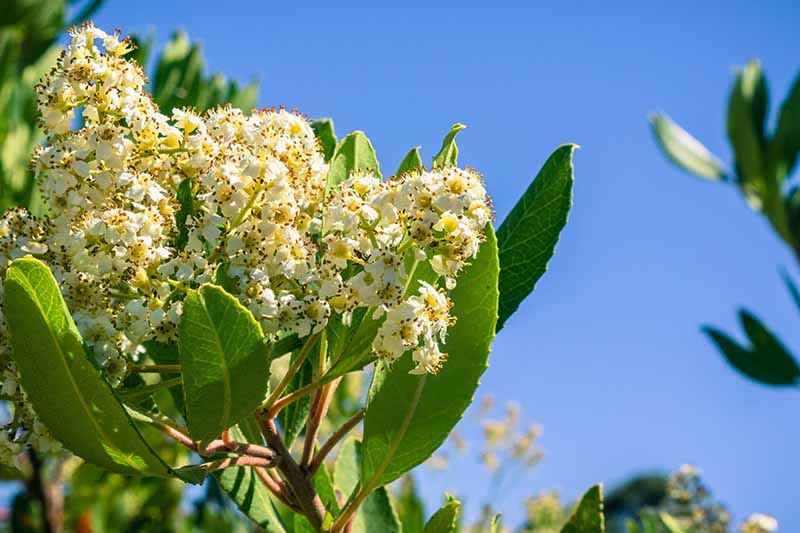
The species name arbutus makes reference to the similarity in leaf structure of toyon to that of the European strawberry tree, Arbutus unido.
Previously, toyon was classified as a species of Photinia, but numerous plants in that genus have been reclassified. For that reason, you may encounter the name Photinia arbutifolia in reference to this plant.
The common name “toyon” is a Spanish transliteration of the indigenous name “tottcon,” used by the Ohlone Native Americans of the central and northern California coast.
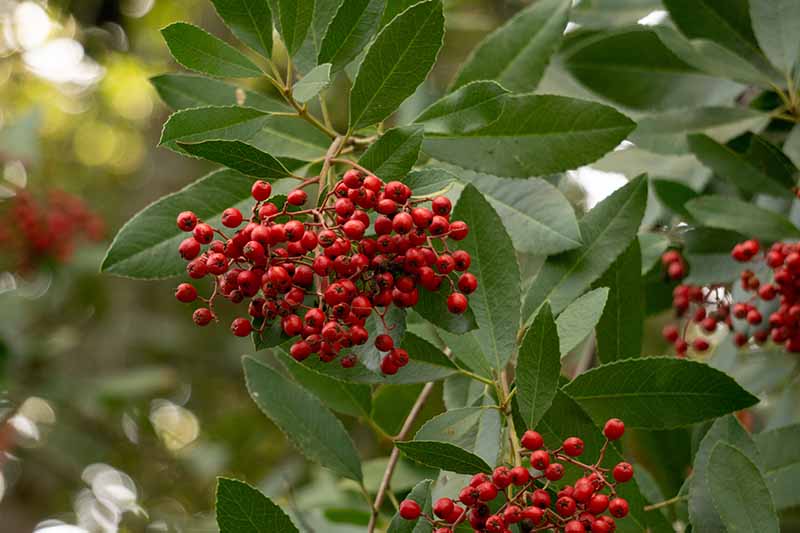
Indigenous groups such as the Ohlone, Chumash, and Tongva tribes utilized the berries as a source of food and medicine, as well as the wood for constructing home goods, weaponry, and offertory poles.
According to Carol Bornstein, one of the most renowned California native plant specialists, “Toyon is the only California native plant that continues to be commonly known by a Native American name.”
You can find more information about this plant and others in Bornstein’s book “California Native Plants for the Garden,” which is available on Amazon.

California Native Plants for the Garden
That being said, toyon became known to most English-speaking migrant Angelenos in the early 1900s as California holly or Christmas berry for its notable similarity to the English holly, Ilex aquifolium.
With little evidence of a traditional “winter” in Southern California, cuttings of red winter berries and holly leaves can bring a festive touch to the holiday season – though in Los Angeles it is illegal to harvest toyon cuttings on public or private land without the landowner’s permission, thanks to overharvesting.
All the more reason to grow your own, and always check local regulations before foraging!
Rumor has it that this plant is the namesake for the legendary Hollywood. However, according to Lila Higgins of the LA County Natural History Museum, the town was in fact named in 1887 by Daeida Wilcox and her land-speculating husband Harvey Henderson Wilcox simply because they liked the sound of the name, not for any particular floral inspiration.

Nevertheless, toyon bedazzles the hills of Hollywood and beyond with its clusters of lightly scented white flowers in the summer, and bountiful red berries in the winter.
Recognizing its immense value as a pollinator attractor, habitat and food source, slope stabilizer, and cultural pillar, Theodore Payne – the English-born horticulturist turned California native plant enthusiast – first introduced this plant into the horticultural trade in the late 1800s.
In 2012, toyon was declared the official native plant of the City of Los Angeles.
Propagation
You can grow your own H. arbutifolia by seed, from cuttings, or by adopting a plant from your local nursery.
From Seed
Germinating toyon seed is relatively easy, but first requires the multi-step process of separating the seeds from the fruit.
The red pomes are made up of an outer fleshy layer that contains an interior seed capsule, with two seeds inside. Harvest the ripe red fruit in November for optimal seed collecting.
Here’s how you can go about extracting the seeds at home:
In order to expose the seed capsules, Lee Gordon from the California Native Plant Society Propagation Committee recommends using a blender to break open the fruit and remove the pulp.
First, place the berries in the blender, and blend them on low to medium speed until the seed capsules are separated from the fruit.
The speed of the blender should be enough to cut into the pulp without damaging the seed capsules. This process may take up to a few minutes.
A more gentle – though time-consuming – alternative is to rub the berries against a rough surface or squeeze them between your fingers until the seed capsules are exposed.
Next, rub the capsules against a sieve to break up and release the seeds. Leave the seeds and capsules in the sieve to dry overnight.
Using a fan or a hair dryer on low heat, separate the seeds from the capsules. Larger growing operations have a special machine for this, but at-home ingenuity works just as well!
Once you have extracted the seeds, you can choose to sow them immediately, or store them in a brown paper bag in the refrigerator for sowing later in the season.
Be sure to label and date the bag with the species name and month of seed collection. Seeds can remain viable for many years, so long as they are properly stored in a cool, dry location.
Sow seeds in late fall or early winter, using a potting medium composed of fast-draining cactus or succulent soil, ideally mixed with native soil from your garden.
Seeds should germinate quickly at room temperature within two weeks after sowing.
If you want to grow lots of toyon, scatter seeds into flats directly on top of the potting soil, spacing the seeds about an inch apart. Keep them consistently moist but not dripping wet by regularly misting the seeds and growing medium.
After a few weeks, when the seedlings have sprouted and grown their first set of true leaves, you can transplant each into its own container. I recommend a four-inch or gallon-size container for this.
If you want to grow just a few plants, you can also sow multiple seeds into one pot, either a four-inch or gallon-size container. As the seedlings grow, select the most vigorous ones to keep, and gently pluck out the rest.
From Cuttings
To propagate cuttings, it’s best to use new growth. Take cuttings in spring or early summer in the morning, from a well hydrated plant.
Antonio Sanchez, California native plant botanist and nursery manager, recommends taking long cuttings of new growth, cutting just above a node.
The longer the cutting, the more plant material you will have for your propagation purposes.
If harvesting multiple cuttings, collect and store them in a plastic bag and spritz with water to keep them hydrated.
When ready to propagate, prepare a growing medium of 80 to 100 percent perlite. The rest can be horticultural sand. Fill three-inch square pots with the growing medium and pack it down so that there are no air pockets.
Next, take each cutting and prune off any limp parts, making sure to cut just above a node. Then, measure out three- to four-inch-long sprigs, dividing each initial cutting into sections.
Cut at a 45-degree angle, in between nodes. You’ll want at least one to three nodes to sit below the surface of the growing medium.
Strip off the leaves from the lower half of each new three- to four-inch cutting, leaving just the foliage at the top. Then, dip the cut end into powdered rooting hormone.
Finally, stick the cuttings into the prepared pots of rooting medium, packing the cuttings in close together. This densely packed rooting environment helps keep the cuttings from drying out. You should be able to fit about 20 cuttings into a three-inch container.
Place the containers in a location with bright, indirect light (either outside or inside) and mist thoroughly. Regularly mist the growing medium to prevent the cuttings from drying out.
Once the cuttings have developed roots, which usually takes at least a month, transplant them into a growing medium of cactus or succulent soil, ideally mixed with native soil from your garden.
Gently detangle the cuttings’ roots and plant them into individual four-inch containers. Water regularly, when the soil is dry.
From Seedlings/Transplanting
Once your toyon tots are fully rooted, or if you have elected to adopt from a nursery, you are ready to plant.
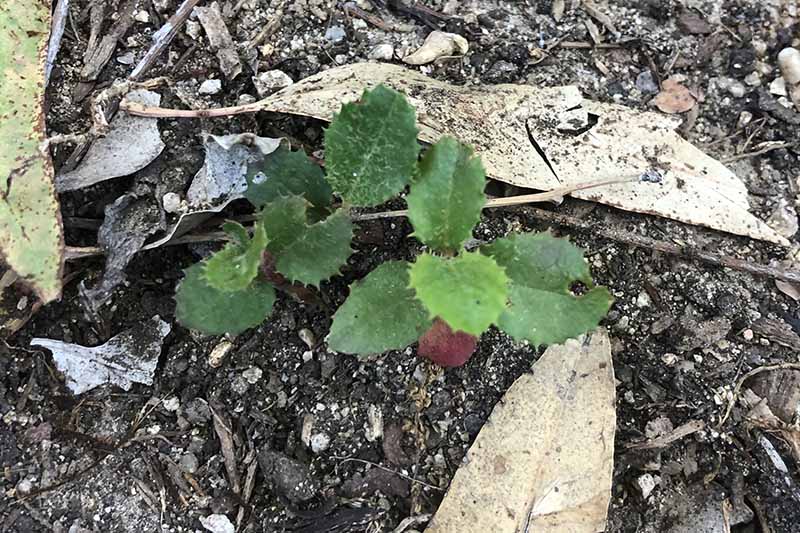
Select a spot in your garden that receives full to part sun and provides ample growing room.
Though the young H. arbutifolia may look unassuming in their early development, don’t be fooled – these friends grow rather quickly and can reach up to 10 feet tall in just a few years.
Gently remove any mulch from the planting area to expose the soil. Dig a hole the same depth and twice as wide as the plant’s container. Try not to mix the soil into the mulch.
Fill the empty hole with water and allow the water to fully drain. This practice not only provides a hydrating and welcoming environment for the plant, but also allows you to observe the moisture retention of the soil.
If the water drains rather quickly, you likely have sandy/fast-draining soil; if it takes upwards of 30 minutes for the water to drain, you likely have clay/slow-draining soil. This information will inform your watering practices down the line.
Once the water has fully drained, remove the plants from their containers, gently disturbing the exterior roots if they are pot-bound, and place in the hole.
Backfill with the native soil, using your fingers to compact the soil so that there are no air pockets.
Apply a three- to four-inch layer of mulch around the base of each plant, leaving a small ring of soil exposed at the trunk so as to provide a little breathing room for the plant.
Mulch helps to regulate soil temperature, retain moisture, and improve overall soil health.
After planting, be sure to give them a deep watering, and lots of love!
How to Grow
Though H. arbutifolia can be grown in Zones 7 through 10, for optimal wildlife and habitat purposes, it is best to plant in areas where they are native (i.e. California, predominantly western portions and the Sierra foothills).
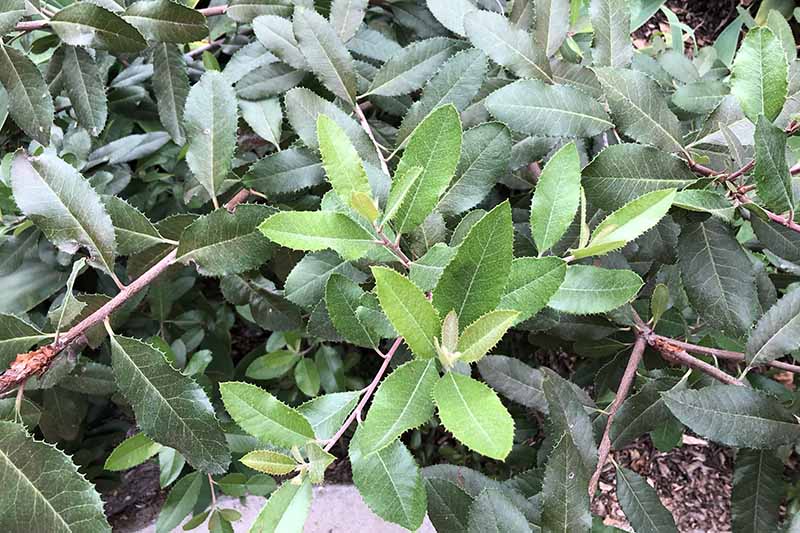
This species does best in full sun to part shade conditions and can grow in a variety of soil types, including sandy, clay, and serpentine soils.
Once established, toyon requires little water. For the first few months after planting, give them a deep and thorough watering once a week.
Then slowly begin to ease up on watering so that you’re just watering once every couple of weeks.
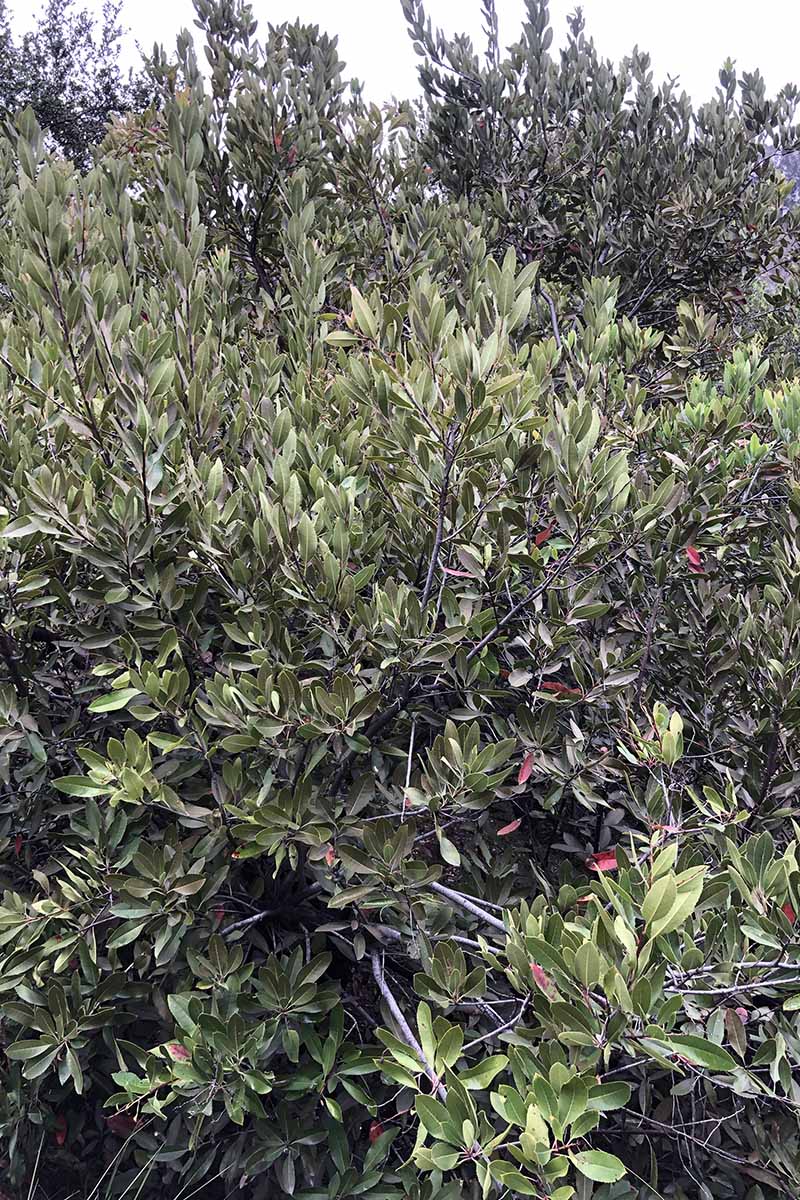
By the time a year has passed, you will need to water just once a month.
If there is a particularly hot spell during the summer, you can water a maximum of two times a month, making sure to look at the weather forecast beforehand so that you avoid leaving the plant with hot, wet feet.
Be sure to water only when the top three to four inches of soil are thoroughly dry.
As with other California native plants, there is no need for soil amendments or fertilizer. If anything, regularly apply mulch.
Growing Tips
- Plant in full sun to part shade.
- Water once a week for the first few months, then decrease frequency gradually to just once or twice a month.
- Apply regular applications of mulch around the base.
Pruning and Maintenance
H. arbutifolia responds well to shapeful pruning. The plant can be encouraged to embrace a more multi-stemmed, shrub-like form as well as a more sculpted tree shape, with a single leader or a few main branches.
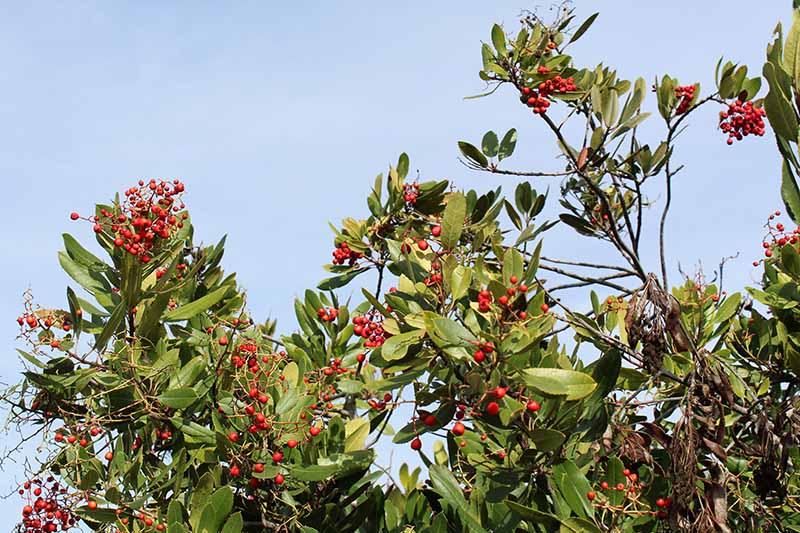
Flowers and fruit are produced on new growth, so prune during winter or early spring after the plant has reached the end of its fruiting cycle. Be sure to cut back any dead or diseased branches.
In order to cultivate a dense shrub, pinch off the tips of the branches.

If choosing a more tree-like form, select a few main branches and selectively prune so as to expose the trunks.
Regularly apply a three to four-inch layer of mulch around the base of the plant as described in the transplanting section above.
Cultivars to Select
For a distinct yellow hued berry, plant H. arbutifolia ‘Davis Gold.’
Similar in stature and overall appearance to the regular toyon species, ‘Davis Gold’ differs in that its white blooms in summer lead to golden yellow pomes instead of the more traditional holly red.

This cultivar makes for a beautiful specimen or attractive hedge plant, on its own or intermixed with other woodland species, such as Ceanothus or coffeeberry.
Originally grown from seed collected in 1962 on Santa Catalina Island, this selection reportedly made its way into the plant trade back in 1962 thanks to a UC Davis grad student by the name of Charles Filmer.
Filmer recognized that the specimen, planted on the UC Davis campus, was easier to propagate vegetatively than others and thus named it ‘Davis Gold.’
If you prefer to grow the species plant with red berries, you can find H. arbutifolia available from Nature Hills Nursery.
Managing Pests and Disease
Though H. arbutifolia is a hardy and long-lived plant, various pests and diseases may cause you trouble.
Fortunately, such issues can be easily thwarted through the incorporation of beneficial insects, targeted pruning, and if need be, low-risk insecticides.
Herbivores
You won’t encounter too much difficulty with herbivores, but occasionally, new growth can be tempting for deer.
Deer
Though toyon is mostly resistant to herbivore predation, deer will still nibble on new growth in dry years.
In areas where deer are prevalent, you can provide protection of sorts (chicken wire, for example) for the plants in order to help them get established.
Insects
Toyon will give off clear signs of distress when bothered by insect predation – namely via leaf discoloration and premature dropping.
In time, other insects will be lured to the area to sort out population imbalances, but you can help your plant along with some additional TLC nonetheless.
Soft Scale
Scales are small sucking insects that attach themselves to the stems, leaves, and fruit. If infested with scale, plants often appear water stressed, with leaves turning yellow and dropping prematurely.
Scale is typically well controlled by beneficial insect predators and parasites. However, this system of checks and balances can be disturbed by the presence of ants, dust, or insecticides that may deter predators and parasites.
If a scale infestation persists, you can selectively prune damaged parts, apply horticultural oil, or use tape traps at the site of infestation.
Thrips
These minute, slender pests are most commonly found on plants with dense foliage and limited airflow, or those grown in too much shade.
Thrips will puncture and suck the insides of the plant, rendering damage that leaves the plant discolored and scarred.
Thrips rarely cause serious injury, but may noticeably affect the plant’s cosmetic appearance, and can ultimately stunt plant growth if left unaddressed.
If dealing with thrips, use your hose to spray them off, or apply soapy water or horticultural oil.
Otherwise, you can simply wait for the thrips’ predators to arrive. Ladybugs, lacewings, and cucumeris mites are just a few that may be enticed to join your garden party.
Read more about thrip identification and control here.
Lace Bug
Lace bugs are tiny, semi-transparent insects that feed on the underside of leaves by sucking the plant’s photosynthetic tissue fluids. This type of attack causes leaf discoloration and stippling.
Ultimately, lace bugs do not present a serious threat to overall plant health, but do they affect aesthetic appearance.
To control these pests, allow beneficial predators and parasites to locate their lace bug feast.
Or, to speed things along, you can purchase assassin bugs, lacewings, or pirate bugs, available at Arbico Organics. Additionally, if the population is simply out of control, use your hose to spray the tiny bugs off the leaves.
Hot, full sun conditions may provide more of an ideal climate for lace bugs to convene on H. arbutifolia. Toyon plants grown in part shade with less extreme heat exposure do not face the same predicament.
Read more about lace bug identification and control here.
Disease
While it is possible for disease to plague your plant friend, best practices such as proper irrigation and selective pruning will help to prevent the onset and spread of most.
Here are a few potential diseases you may encounter:
Collar, Foot, and Crown Rots
Root and stem rot is most likely a cause of improper irrigation. To prevent this disease, avoid extremes in soil moisture by watering deeply and infrequently.
Once plants are established, water thoroughly, twice a month maximum.
Clay soils drain much more slowly than sand, so be sure to check the soil moisture with your finger or a moisture meter before watering to prevent adding too much.
Fire Blight
Fire blight is a bacterial disease that causes branches to die back. In spring, branches and trunks may show symptoms, with fluid oozing from cankers.
Open flowers are the most common site of infection, ultimately leading to wilt and dead, blackened leaves and fruit – giving the shrub a tough, scorched appearance.
Once infected, the plant will harbor the pathogen forever.
In order to control the spread of this disease, remove all affected branches well below the site of infection. Pay special attention to sterilizing your tools with alcohol between each cut, and after use.
Scab
Scab is a fungal disease that causes spotting on and premature dropping of leaves and fruit.
Scab first appears as pale or yellow spots, then darkens to brown-gray discoloration on leaves, fruits, and occasionally stems as well.
Fungi spores overwinter on fallen leaves, so remove all infected leaves from the ground to prevent further spread down the line.
Scab thrives in humid, rainy, or heavily irrigated conditions, so prune dense canopies to improve air circulation, and above all, avoid overwatering. Hot, dry weather slows disease development.
Best Uses
These majestic evergreen beauties are best incorporated into habitat gardens and restoration zones. Supreme slope stabilizers, they provide robust forage and habitat for California wildlife.

Additionally, H. arbutifolia makes for an excellent natural hedge – on its own or interplanted with other chaparral shrubs and trees such as coffeeberry and Ceanothus species.
Quick Reference Growing Guide
| Plant Type: | Evergreen woody shrub or small tree | Flower / Foliage Color: | White/emerald green |
| Native to: | California Floristic Province | Maintenance: | Low |
| Hardiness (USDA Zone): | 7-10 | Tolerance: | Fire |
| Bloom Time: | Spring-summer | Soil Type: | Various, including sand, clay, serpentine |
| Exposure: | Full sun to part shade | Soil pH: | 5.0-7.8 |
| Spacing: | 6-8 feet | Soil Drainage: | Well-draining |
| Planting Depth: | Same as container height | Companion Planting: | Manzanita, California sagebrush, milkweed, California lilac, giant wild rye, buckwheat, monkeyflower, penstemon, oak, sage |
| Height: | 8-10 feet | Uses: | Habitat gardens, slope stabilization, hedge |
| Spread: | 6-8 feet | Family: | Rosaceae |
| Time to Maturity: | 3 years | Genus: | Heteromeles |
| Water Needs: | Low | Species: | Arbutifolia |
| Common Pests: | Flatheaded borers, Fuller rose beetles, soft scale, thrips, lace bugs, whiteflies, Western tent caterpillars, Western tussock moths | Common Diseases: | Fire blight, leaf spot, rot, scab, sudden oak death |
Cultivating Relationships
Working with plants native to your area allows you to develop relationships with not just the plant itself, but the land, the history, and all of the beings that have passed through.

As your hands dig into the soil, you dig deeper into the interconnectedness that unites us all.
Cultivating toyon can lead to all sorts of connections with wildlife, including mockingbirds, American robins, and cedar waxwings – just a handful of the birds that like to feast on the red California holly fruit.
Growing habitat gardens helps to bridge the false divide between humans and the rest of the world.
Especially in urban areas, with so many layers of separation between us and the earth – concrete, asphalt, rubber, and so on – it is crucial to cultivate spaces of refuge and healing for all beings, not just the human species.
Toyon is just the plant to help you begin, rekindle, or further that practice.
Quickly growing to nearly full size in just a few years, this evergreen beauty is host to diverse populations of insects, pollinators, birds, and more. Intrinsic to California chaparral, H. arbutifolia helps to establish a sense of place in this quickly moving world.
Drop a comment below on your experience working with toyon and other California native plants – we’d love to hear from you!
And for more information on growing shrubs in your garden, check out some of these articles next:
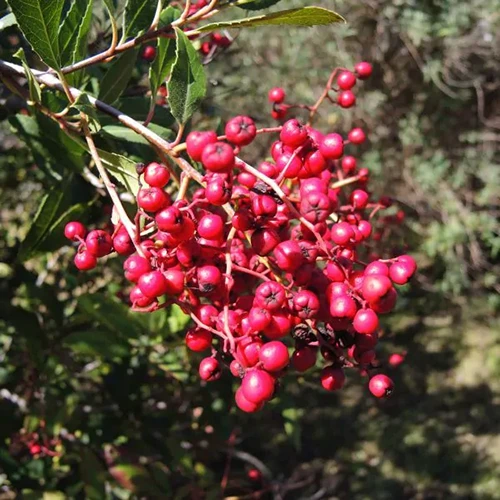
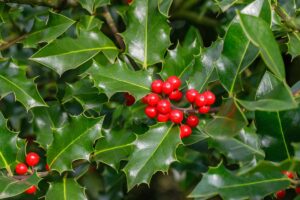
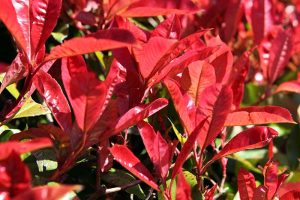
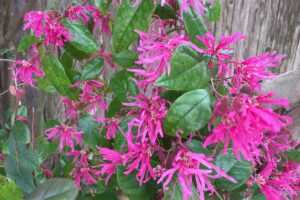
A very in depth article with lots of good information.
But you have multiple photos of completely different non-native species in there.
Pyracantha and cotoneaster can fool some folks, but in an article like this, its really a faux pas you need to fix
Hi Jhonny, thank you for your comment and kind words. We will look into this and correct any of the pictures that are mislabeled.
Great article on the Toyon. Thank you. How do these do in containers? We are in the Davis area. Thank you
Toyon can be grown in a large container, as long as you give it what it needs.